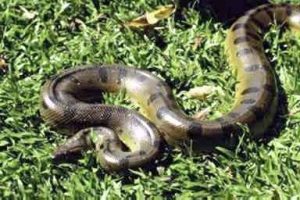GREEN ANACONDA
 Scientific name : Eunectes murinus
Scientific name : Eunectes murinus- IUCN Status : Least Concern
- Green anacondas are the heaviest snakes in the world. The heaviest anaconda ever recorded was 227 kilograms.
- Green anacondas are found in large parts of South America as well as a few Caribbean Islands.
- Prior studies determined that the anaconda’s possible crush force is 90 pounds per square inch. That’s comparable to an elephant sitting on your chest.
- In the wild, green anacondas live for around 10 years, and around 30 years in captivity.
- Green anaconda’s green skin and dark markings provide camouflage against the green water and rainforest foliage.
- Green anacondas spend much of their lives in, or near, water.
- They are opportunistic apex predators and eat a wide variety of prey.
- Juveniles tend to eat fish, birds and small mammals. Adults are able to consume much larger animals, including deer, capybara, caimans and large birds.
- Large groups of piranhas may gang up on an older, weaker anaconda near the end of its life. Caimans, which are smaller members of the alligator family may also prey on smaller or weaker anacondas, although, when the anaconda is full grown, it is known to prey on the caiman.
- Most of their time is spent in the water hunting. Although they use both sight and smell to hunt, they also have the ability to sense heat emitted by potential prey.
- Green anacondas prey on a variety of animals including fish, birds, tapirs, wild pigs, capybaras, and caimans (reptiles similar to alligators).
